
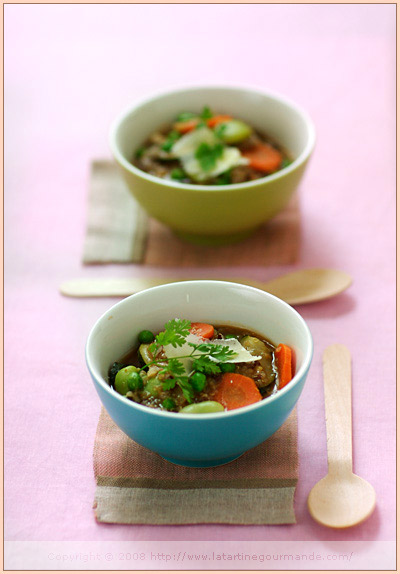
“What on earth are you doing?” P. asked when he heard the noise of pots and pans clanking.
“Looking for a large stockpot,” I replied as I was kneeling on the kitchen floor, busy checking the bottom shelf of the kitchen island clearly overloaded with too much stuff. Where on earth was my large stockpot indeed?
“What for?”
I paused, wondering whether I should tell him then, or later.
“Minestrone soup,” I said. “For lunch.” I knew well what he was going to say, but let him say it all the same.
“I have to tell you, I don’t really like minestrone soup,” he said in a quiet tone, an indication that he was trying to be nice about it.
“Ca tombe bien, moi non plus !” I replied with a loud laughter (Good, me neither!)
“But wait until you try this one.”
This is how Sunday started: a conversation revolving around minestrone soup, and my determination to have the memory of poor-tasting minestrone soup disappear for both of us. Gone! Pouf, disparu, as if it had never existed.
But tell me one thing first. Are we the only ones to feel this way about minestrone soup? When my friend R. and her boyfriend J. stopped by to see us late on Sunday morning — and eventually stayed over for lunch — R. told us that she did not like minestrone because of the beans.
“There are just too many types of beans in a minestrone. But Béa, I have to say. This one is really nice. Actually, maybe you should not call this a minestrone soup, but something else” she continued.
“Really?” For a second, I did not know what else to answer. It was a minestrone soup in my book, after all.
“Well, I will call it My minestrone soup then. How does this sound?”
Unlike R., it is not necessarily the beans that I used to mind in a minestrone soup, but the flavor of the broth. I suppose that I must have eaten too many bad minestrone soups, in average restaurants where it was the only attractive dish on the menu, or at the canteen where I would have lunch every day when I was in middle and high schools; minestrone was on the menu every Wednesday during the fall.
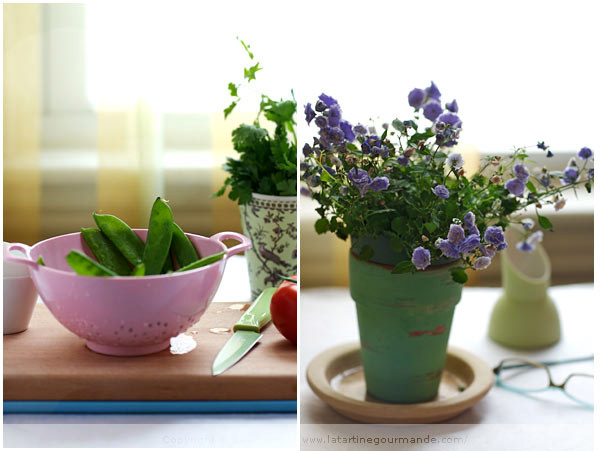
In a minestrone more than with any other soup, I believe that the broth is really the backbone that supports the entire soup. A good broth needs to have a clear fragrant flavor, not overwhelmingly so, but one that will bring the dish a step up. If it is poor in quality, then the soup will too. I realized this simple thing once I started to prepare my own vegetable stock. From that time on, I went from hating minestrone soup to loving it, from finding some risotto recipes average to craving them every day.
Maybe you will think that you clearly do not have the time to make homemade vegetable broth. And, in the case we were talking about chicken, fish, beef or veal stock, perhaps I would join the crowd. The story of a vegetable broth, however, is a complete different one, because a vegetable stock is quick to make. The key? Be a touch organized in your shopping.
I always make sure to add the ingredients necessary to making a vegetable broth to my shopping list, should I have a spontaneous urge to making one. In fact, I no longer need to remind myself because these ingredients systematically end up in my cart. It has become a shopping habit, and for once, a good one.

- 1 fennel bulb
- 2 to 3 carrots
- 1 to 2 celery branches
- 1 onion or 1 shallot
- 1 leek
These are the basic vegetables that I like to use to prepare a simple, scrumptious vegetable broth. Ten minutes to prepare, and twenty minutes to cook. It is so easy that it almost happens on its own. And the good news? It can be prepared one or two days before.
The rest, thyme, peppercorns, coriander and fennel seeds should be basic spices in your kitchen pantry. They are in mine.
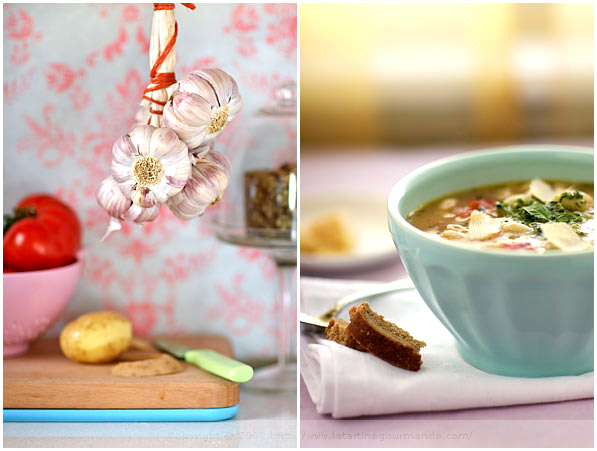
You need:
- 2 Tbsp olive oil
- 1 onion
- 1 garlic clove
- 5 to 6 coriander seeds
- 5 to 6 fennel seeds
- 2 to 3 thyme twigs
- A few peppercorns
- 1 fennel bulb, cut in big pieces
- 1 leek, cleaned and sliced
- 2 carrots
- 2 celery branches
- Salt
- 6 cups water
Steps:
- Peel the vegetables and cut them in big pieces.
- In a large stockpot, heat the olive oil and add the onion, garlic and spices. Cook for a few min, without browning.
- Add the vegetables and cook on medium to low heat for 10 min, until soft.
- Add the water and season with salt. Cover and bring to a simmer, and cook for 20 min. Remove from the heat and let rest for a few hours (or even overnight in the fridge) for the flavors to develop even more. Strain the broth and use when needed. It keeps well in the fridge for a few days.
Ingrédients :
- 2 càs d’huile d’olive
- 1 oignon
- 1 gousse d’ail
- 5 à 6 graines de coriandre
- 5 à 6 graines de fenouil
- 2 à 3 brins de thym
- Quelques baies de poivre noir
- 1 bulbe de fenouil
- 1 poireau
- 2 carottes
- 2 branches de céleri
- Sel
- 1,5 litre d’eau
Étapes :
- Épuchez les légumes et coupez-les en gros dés.
- Dans un grand faitout, faites revenir l’oignon, l’ail et les épices dans 2 càs d’huile d’olive (sans brunir).
- Ajoutez tous les légumes et faites-les suer pendant 10 min.
- Versez l’eau, salez et couvrez. Faites mijoter pendant 20 min. Arrêtez le feu et laissez reposer quelques heures (ou toute la nuit au frigo) pour que les saveurs se développent encore plus. Filtrez le bouillon et utilisez-le de suite ou réservez. Le bouillon se conserve bien pendant quelques jours au frigo.
You probably know that a minestrone is a thick Italian soup made with various seasonal vegetables (such as tomatoes, celery, carrots, onions, beans, fennel, peas), to which pasta or rice is often added, as well as sometimes meat. There are probably as many minestrone soup recipes as Italian cooks. While some like the soup thick and dense in texture, others prefer it thin with more broth. Perhaps a minestrone (from minestra in Italian) is to the Italians what a bouillabaisse is to the French: an unpretentious substantial soup once considered food to feed the poorest families.
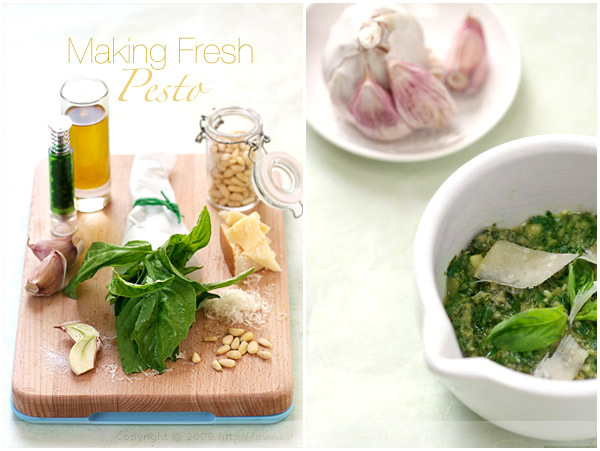
I like to add a touch of pesto in mine, like in a Genoese minestrone, use pecorino instead of parmesan, and then alternate the grains added to the broth. Sometimes I also prefer to sauté the vegetables in olive oil before adding the broth. I play with one variant, then with another one. In fact, over the past two weeks, I was so taken by this cooking project that I made it a few times for lunch. Crazy me or obsessive me? Let’s just say that I did so as a way to test and improve the recipe, and to try different variations using the same basis. Needless to say that it made my lunches pretty happy, with the soup tasting even better the next day.
In my first one, I used Red Rice of Camargue and quinoa, and added fava beans and cannellini beans. In the second one, I used rice pasta, and for the third penne. I keep so many grains in my pantry that the possibilities were in fact wide open — and you will probably see that rice is a king ingredient in my pantry. Is it in yours too?
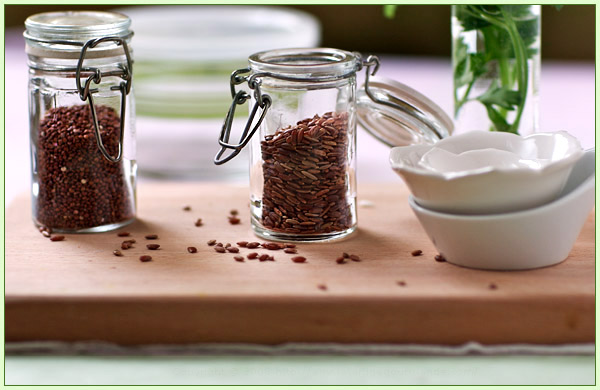
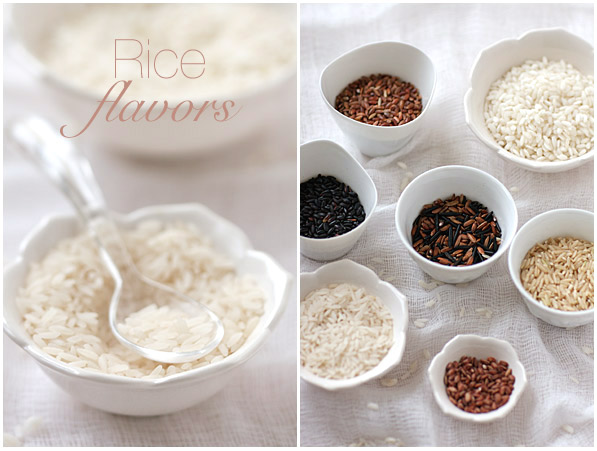
- Forbidden black rice
- Red Rice of Camargue
- Wild rice
- Brown rice
- White Jasmine rice
- American long rice
- Carnaroli rice
- Sushi rice
- Wild rice
- White quinoa
- Red quinoa
- Millet
- Israeli couscous
- Couscous
- Polenta
- Farfalle
- Penne
- Ink Spaghetti
- Quinoa Spaghetti
- Spaghetti
The types of vegetables added to the minestrone depends on your taste, and seasonability. I particularly like minestrone with snap peas, zucchinis and fennel finely sliced, and like to keep these vegetables on the crunchy side. If the vegetables are not in season but I am still craving them, I then simply convince myself that there are worth crimes I could commit. N’est-ce pas ?
And the bottom line is?
J. and R. loved the soup, and P. was asking for more. We enjoyed it with extra shaved pecorino, and fried slices of Spanish chorizo on the side — the next day, I topped the soup with more.
And no matter how I decided to call the soup, it really tasted heavenly. Especially with a nice piece of crusty bread to dip in, and good company to share it with on a lazy Sunday lunch.
So when is a day like this one coming next?
On another note, P. and I are quite lucky to be invited to S.‘s wedding, one of our Italian friends, in April. I like when our friends get married, especially if it happens in Italy! We will be off to Milan, driving to Rome. Any tips you might have are welcomed. Our plan is to visit and walk in Cinque Terre, amongst other things.
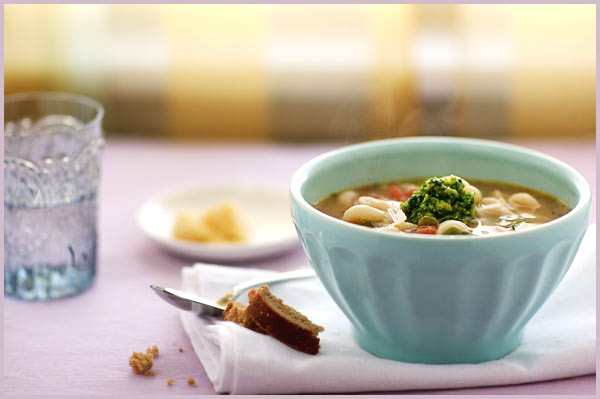
You need:
For the soup:
- 1.5 quarts homemade vegetable broth
- 4 tomatoes, blanched, peeled, cored, seeds removed, then diced
- 2 garlic cloves, peeled and halved
- 2 thyme twigs
- 3 oz Red Rice of Camargue**
- 3 oz quinoa, red or white**
- 1 small fennel bulb, sliced thinly
- 1 carrot, peeled and sliced thinly
- 1 small zucchini, sliced thinly
- 1 cup snap peas
- 1/2 cup fresh or frozen peas
- Homemade pesto*
- Salt and pepper
- Fresh basil
- Extra pecorino, shaved
- Dash of olive oil
** or 5 oz pasta to replace quinoa and rice
*Simple Basil Pesto :
- 1/2 cup fresh basil, chopped
- 2 garlic cloves, peeled and halved
- 2 Tbsp pine nuts
- 1 oz pecorino cheese (or parmesan), grated finely
- 1/8 cup (or more) olive oil
- Dash of salt and pepper
Steps:
- To prepare the pesto, if you use a mortar and pestle, add the ingredients in this order: salt, garlic, basil, pine nuts, pepper, cheese and olive oil, and work with the pestle into a coarse paste.
- If doing by hand, chop the pine nuts and basil. Chop the garlic thinly and mix the ingredients together. Then add the cheese and pour the olive oil slowly while mixing.
- To prepare the soup, pour the broth in a large pot and bring to a simmering point. Add the garlic cloves, thyme, basil leaves, salt and pepper, and add the rice and quinoa (or pasta which you might want to add a little later, depending on how long they need to cook for. Check on the package).
- Add the tomatoes and simmer covered for 20 min or so.
- Add the carrot and fennel slices and continue to cook for 3 to 5 min before adding the zucchini, snap peas and peas. Cook for an extra 3 to 5 min. Season to taste.
- Serve the soup in large bowls with a dash of olive oil, 1 full tsp pesto (or more), extra shaved pecorino and fresh basil.
Ingrédients :
Pour la soupe :
- 1,5 l de bouillon de légumes maison
- 4 tomates, ébouillantées, pelées, épépinées, et coupées en petits dés
- 2 gousses d’aïl, pelées, degermées and coupées en deux
- 2 branches de thym
- 80 g de riz rouge de camargue**
- 80 g de quinoa, rouge ou blanc**
- 1 petite bulbe de fenouil, émincée finement
- 1 carotte, pelée et coupée en rondelles fines
- 1 petite courgette, coupée en rondelles fines
- 100 g de pois mange-tout
- 60 g de petits pois surgelés ou écossés
- Pesto maison*
- Sel et poivre
- Basilic frais
- Copeaux de pecorino pour servir
- Filet d’huile d’olive
** ou 150 g de pâtes, selon votre choix
*Pesto au basilic tout simple :
- 1 gros bouquet de basilic frais
- 2 càs de pignons de pin
- 2 gousses d’aïl, pelées et coupées en deux
- 30 g de fromage pecorino (ou parmesan) râpé finement
- 30 ml (ou plus) d’huile d’olive
- Pincée de sel et de poivre
Étapes :
- Pour préparer le pesto, si vous disposez d’un pilon avec mortier, ajoutez les ingrédients dans cet ordre : sel, aïl, basilic, pignons de pin, poivre, fromage et huile d’olive versée en filet tout en pilant, afin d’obtenir une pâte de la consistance souhaitée. Mon pesto est en général assez humide.
- Si vous le réalisez sans mortier, hachez les pignons de pin et le basilic avant, et râpez l’aïl finement. Mélangez ensuite les ingrédients ensemble, sauf l’huile que vous versez en dernier en filet.
- Pour préparer la soupe, versez le bouillon dans une grosse cocotte (ou un faitout) et ajoutez deux gousses d’aïl, le thym, quelques feuilles de basilic ciselées, les tomates et assaisonnez de sel et de poivre. Amenez à peine à la première ébullition, puis ajoutez le riz et le quinoa (ou les pâtes). Si vous utilisez des pâtes, faites attention au temps de cuisson qu’elles nécessitent, et ne les ajoutez pas trop tôt (voyez le temps de cuisson nécessaire sur le paquet).
- Laissez mijoter à couvert pendant 20 min.
- Ajoutez ensuite les rondelles de fenouil et de carotte, et poursuivez la cuisson pendant 3 à 5 min avant d’ajouter la courgette, les petits pois et les pois mange-tout. Poursuivez la cuisson pendant 3 à 5 min. Rectifiez l’assaisonnement.
- Servez la soupe en assiette creuse. Arrosez d’un filet d’huile d’olive et servez avec 1 grosse càc de pesto (ou plus) des copeaux de pecorino et du basilic frais.

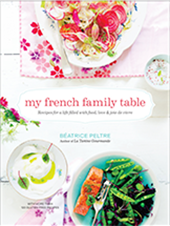
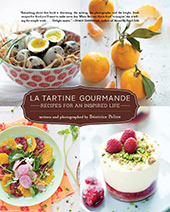
Une belle soupe qui me ferait du bien après une bonne journée de ski… Très belles images qui annonceraient presque le printemps.
Moi aussi j’ai acheté des carottes violettes à la Grande Epicerie de Paris (Bon Marché)…
Sounds heavenly Béa, think I shall give your version a try, as I was thinking of soup with some Salzbrezeln – pretzels I’m planning tonight.
A poetic post with awe inspiring pictures. Do you take the pictures on a different day than cooking? I find it very hard to click, cook and serve on the same day.
If you go to Cinque Terre do not go there by car. You will be very scared and slow moving on those steep roads. There’s a train that goes there. I suggest parking your car at the station and taking it. Also, I recommend staying at:
PENSIONE RISORANTE CECIO
VIA SERRA, 58
CORNIGLIA ( CINQUE TERRE)
LA SPEZIA
http://www.cecio5terre.com
Italy, how exciting! this soup looks so comforting, Bea!
I agree with Katie about driving in CinqueTerre: we live in Milan and we prefer taking the train rather than drive in Cinque Terre. If you don’t have a resident sticker on the car, you have to leave it outside the center anyway and walk into town… The path linking all 5 villages make for a lovely stroll, though… I’m adding you to Flickr in case you would like to know about traveling around Italy…
À chacune de mes visites, ‘j’en prends plein les yeux. Tes compositions ont l’air toutes simples et pourtant…. Que de talent, j’admire vraiment.
what a beautiful rendition of a staple soup! your photos are so mouthwatering and inspiring. you really capture the natural beauty of your ingredients in all their glory.
C’est vraiment a tomber !! bravo comme toujours
Ciao Bea – I do hope you’ll plan to stop and have a coffee in Milan with some of your blog readers! (Me and Bananeira, for example!)
If you have any specific questions, send me an email. April could be a very nice time to be in Italy!! April 25th is a holiday.
HI Bea! Italy is gorgeous, I went to Cinq Terra last year, do check out my blog for places to go there. I would say not to drive in Cinq Terra as the roads are narrow and bad, pitched on steep slopes and its very stressful. Stay at La Spetzia and train (very short) up to the different towns. I was also in Tuscany if you’re interested in that area?
lovely. Those layout photos are so pretty, tidy and luminous, it makes me want to make vegetable broth right away. I did a huge batch of chicken stock yesterday, though, so I think I´m served for a little while.
Très beau billet, très belle atmosphère
J’ai pensé à toi quand j’ai publié un billet dernièrement, puisque on vient peu ou prou du même endroit, si tu veux un petit morceau de Lorraine pendant quelques minutes, c’est par ici:
http://beaualalouche.canalblog.com/archives/2008/01/26/7676820.html
well where else would you cook!? haha. sorry couldn’t resist.
on your way down to Roma, try to stop in the Maremma (Grosseto, Orbetello, Il Giardino = Nicky de St Phalle, south of Tuscany, still authentique… So much to see in this region !
Tes photos sont de plus en plus belles. En plus, on se met à apercevoir des petits morceaux de ta cuisine (la pièce), ça j’adore 😉
Mmm…I just made minestrone yesterday from whatever vegetables I could find at the market that morning. Such a wonderful, tasty comfort food in the winter no matter how you make it or what you call it.
I’m much further south in Italy than you’re headed, but buon viaggio 🙂
I never thought of putting the pesto in soup, but it does make sense. These are some great soup making tips and of course the pictures are so beautiful as usual! : )
Lovely! I don’t like minestrone soup either, but I bet I would love yours. Quinoa spaghetti?!? That sounds amazing, but I’ve never seen it anywhere! And I love the idea of adding fennel and leek to a vegetable stock — so much better than just a mirepoix!
Such a perfect soup for these cold days. I like the thought of adding grains to it! I happen to love minestrone but yours seems like such a lovely take on it.
Beautiful photos, Béa. Your minestrone looks delicious, I’ll try your recipe as soon as posible. Thanks for sharing 🙂
les cinque terre est un lieu magique, il faut les découvrir à pied par les sentiers qui longent la mer et relient les 5 villages, c’est un enchantement pour le coeur et l’esprit
What a beautiful composition! You know Bea, I’m not too fond of minestrone soup either but I’ll be happy to have this.
You are in my list for “You Make My Day Award”.
Come in my blog… if you want!
delicieux! I think this would go really well with fried chorizo…
Sounds (and looks) lovely. My main thoughts of minestrone are too-salty, too-tomatoey, and too-fake-soupy; those thoughts could certainly do with a revival.
I have yet to try a good cup of Minestrone. But I can almost get a whiff of yours coming through 🙂
I’ve never had a bowl of minestrone that I truly enjoyed, only minestrone that was tolerable.
My pantry has a lot of overlap with yours, so I must be doing something right!
Us vs. Food
Minestrone has such a bad reputation — maybe from so many school cafeterias when we were kids! Not one of your variations reminds me of any of the minestrone we were served in school — in fact, I’m inspired to make a pot this weekend!
yummy~
Mais comment fais tu pour rendre de simples legumes sexy? Des fois, quand je vois ca, je me sens decouragee. D’autres fois, je me contente d’admirer, tout simplement.
Man, I so want to hire you to take photos for my blog! Beautiful!
You know, we had a restaurant in town that made the BEST minestrone soup, but then they burned down when I was about 12 or 13, and ever since then nothing has measured up. Too many beans bland broth, not enough veggies, all of the above. I thought I was just picky because I had tasted what it could be, and nothing would ever measure up again. Glad to see I am not just overly picky!
Delicious! This is certainly the time for soup.
Many thanks everyone, once again. Sorry that I do not have the time to answer each of you individually, but know however that I appreciate every single one of you comments. There will be more Kitchen shots (hint hint Clea), I am in the mood for that these days, just do not know why…It is simply nice to try different things, and play with them to see what happens.
I have a minestrone soup I love already but I am so going to try it with your broth!!! Sounds lovely.
Toutes ces photos sont terribles!! C’est la première fois que je passe sur ce blog. Je suis passionnée de cuisine et de photos. Je me régale! Et je dévore toute cette beauté avec mes yeux!
Btw, many many thanks for the tips about Italy. I am still in the planning phase, so this is great. And if I can meet some of you while there (ex in Milan), absolutely!
Pingback: a morning « Radical Muffin
The pesto photo It’s a book in the making just fab.
Pingback: Tartines and Broccoflower Soup, nothing else — Des tartines et une soupe au brocofleur, rien d’autre by La Tartine Gourmande
Pingback: Lunching on a Jerusalem Artichoke Soup — Déjeuner avec une soupe aux topinambours by La Tartine Gourmande
Pingback: Design*Sponge » Blog Archive » in the kitchen with: béatrice peltre
Pingback: Rutabaga and Avocado Soup — Une soupe au rutabaga et à l’avocat by La Tartine Gourmande
Pingback: Root Vegetable Chips with a Soup — Des chips de légumes-racines avec une soupe by La Tartine Gourmande
Just found your beautiful website, full of wonderful recipes and advice! Thanks! On Italy, try to stay near the Piazza Navona. If you do this, you will be centrally located to all the best sites, plus five minutes walking from Campo de Fiori, the main food market. Try to visit the Spice guy! Rome is wonderful – have fun and visit the Trevi Fountain late at night. Magic!
Pingback: Everyday Comfort Food — Cuisine réconfortante de tous les jours by La Tartine Gourmande
Pingback: Sunday Laziness, and Popsicles — Paresse du dimanche et sucettes glacées by La Tartine Gourmande
oohh.. must try. I have been searching for a good veg broth recipe, ont that’s not too fussy. Very important for vegetarians to have.
Thank you!!
Pingback: Nourishing Soups — Des soupes nourrissantes | La Tartine Gourmande
Hi! I just made this broth, it hasn’t had time to rest yet, but it’s fantastic already! Thanks so much for the recipe! Much better than using store bought or those full of sodium bouillon cubes… Super simple!
Pingback: Aetheriae noctes » Archive du blog » Cuisine de saison
This is my new go-to recipe for both veggie broth and minestrone. I love the addition of fennel to the broth. It gives it a great clarity and fresh taste, not overpoweringly sweet like many veggie broths.